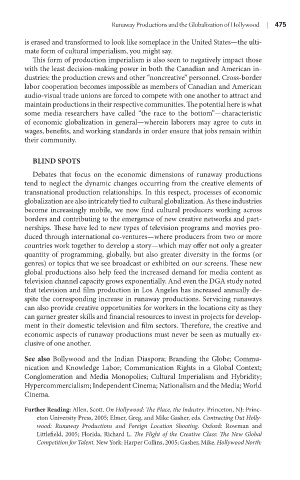Page 496 - Battleground The Media Volume 1 and 2
P. 496
Runaway Product ons and the Global zat on of Hollywood |
is erased and transformed to look like someplace in the United States—the ulti-
mate form of cultural imperialism, you might say.
This form of production imperialism is also seen to negatively impact those
with the least decision-making power in both the Canadian and American in-
dustries: the production crews and other “noncreative” personnel. Cross-border
labor cooperation becomes impossible as members of Canadian and American
audio-visual trade unions are forced to compete with one another to attract and
maintain productions in their respective communities. The potential here is what
some media researchers have called “the race to the bottom”—characteristic
of economic globalization in general—wherein laborers may agree to cuts in
wages, benefits, and working standards in order ensure that jobs remain within
their community.
BLinD sPoTs
Debates that focus on the economic dimensions of runaway productions
tend to neglect the dynamic changes occurring from the creative elements of
transnational production relationships. In this respect, processes of economic
globalization are also intricately tied to cultural globalization. As these industries
become increasingly mobile, we now find cultural producers working across
borders and contributing to the emergence of new creative networks and part-
nerships. These have led to new types of television programs and movies pro-
duced through international co-ventures—where producers from two or more
countries work together to develop a story—which may offer not only a greater
quantity of programming, globally, but also greater diversity in the forms (or
genres) or topics that we see broadcast or exhibited on our screens. These new
global productions also help feed the increased demand for media content as
television channel capacity grows exponentially. And even the DGA study noted
that television and film production in Los Angeles has increased annually de-
spite the corresponding increase in runaway productions. Servicing runaways
can also provide creative opportunities for workers in the locations city as they
can garner greater skills and financial resources to invest in projects for develop-
ment in their domestic television and film sectors. Therefore, the creative and
economic aspects of runaway productions must never be seen as mutually ex-
clusive of one another.
see also Bollywood and the Indian Diaspora; Branding the Globe; Commu-
nication and Knowledge Labor; Communication Rights in a Global Context;
Conglomeration and Media Monopolies; Cultural Imperialism and Hybridity;
Hypercommercialism; Independent Cinema; Nationalism and the Media; World
Cinema.
Further reading: Allen, Scott. On Hollywood: The Place, the Industry. Princeton, NJ: Princ-
eton University Press, 2005; Elmer, Greg, and Mike Gasher, eds. Contracting Out Holly-
wood: Runaway Productions and Foreign Location Shooting. Oxford: Rowman and
Littlefield, 2005; Florida, Richard L. The Flight of the Creative Class: The New Global
Competition for Talent. New York: Harper Collins, 2005; Gasher, Mike. Hollywood North:

